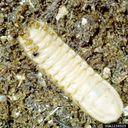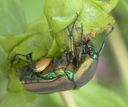Green June Beetle
Cotinis nitida
Classification
- Phylum: Arthropoda
- Subphylum: Hexapoda
- Class: Insecta
- Order: Coleoptera
- Suborder: Polyphaga
- Superfamily: Scarabaeoidea
- Family: Scarabaeidae
- Subfamily: Cetoniinae
- Tribe: Gymnetini
- Genus: Cotinis
- Species: nitida
Pronunciation
How to pronounce Cotinis nitida: /koʊˈtiːnɪs ˈnɪtɪdə/
These audio files are automatically generated. While they are not always 100% accurate, they are a good starting point.
Images






Summary
Cotinis nitida, known as the Green June Beetle, is a beetle species prevalent in the eastern U.S. and Canada, recognized for its vibrant color and economic implications as a pest during its larval stage.
Physical Characteristics
Adults: 15–22 mm long, dull metallic green wings; sides are gold, and the head, legs, and underside are bright shiny green. Larvae are white with a brownish-black head, growing to approximately 40 mm.
Identification Tips
Distinguished from Cotinis mutabilis by size and coloration; larger body index and vibrant green coloration. May have yellow or light brown margins with a metallic green or brown underside.
Habitat
Commonly found in lawns, fields, and forests, with a preference for organic-rich soils during the warmer months when they reproduce.
Distribution
Found across the eastern United States and Canada, from New Brunswick to Georgia, and west as far as California. Most abundant in the South.
Diet
Adults feed on soft-skinned fruit like berries, grapes, peaches, nectarines, apples, pears, and figs. Larvae feed on roots and organic matter in the soil.
Life Cycle
The complete life cycle lasts one year, with egg hatching in approximately 18 days, and adults emerging in June after a pupation period.
Reproduction
Mating occurs in the early morning, with females laying 60 to 75 eggs underground. Eggs appear white and become spherical as the larvae develop.
Predators
Adult beetles are consumed by birds like robins, blue jays, and brown thrashers. Larvae are predated by moles and other mammals during rainy periods.
Ecosystem Role
As a decomposer, it plays a role in nutrient cycling; however, larvae can cause damage to plant root systems.
Economic Impact
Cotinis nitida is economically significant due to the potential damage to crops, leading to increased pesticide use and subsequent environmental concerns.
Collecting Methods
- Light traps
- Hand collection during day
- Soil sampling
Preservation Methods
- Drying specimens
- Freezing specimens for a period
Misconceptions
Often confused with Cotinis mutabilis, leading to incorrect assumptions about its agricultural impact.
Tags
- Cotinis nitida
- Green June Beetle
- Beetle
- Insect
- Scarabaeidae